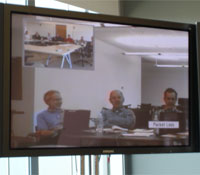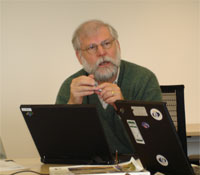Leading Department of Energy Genome Scientist to Direct Joint Marine Microbial Metagenomics Cyberinfrastructure Initiative
April 27, 2006 / By Stephanie Sides
|
San Diego, CA, April 27, 2006 – An experienced genomics science program administrator has been recruited to direct a $24.5-million effort to develop an innovative cyberinfrastructure that will allow scientists to organize and analyze a vast amount of data on the genomes and community ecologies of ocean-dwelling microbes.
Paul Gilna will become the executive director of the Community Cyberinfrastructure for Advanced Marine Microbial Ecology Research and Analysis (CAMERA) project. He was appointed to the position by the University of California, San Diego (UCSD), and the California Institute for Telecommunications and Information Technology (Calit2). This project partners Calit2 with the Rockville, MD-based J. Craig Venter Institute, UCSD’s Center for Earth Observations and Applications based at Scripps Institution of Oceanography, and the San Diego Supercomputer Center (SDSC). Gilna replaces interim director Peter Arzberger, director of Life Science Initiatives at UCSD.
Gilna is the former director of the Department of Energy’s Joint Genome Institute (JGI) operations at Los Alamos National Laboratory (LANL) and group leader of Genomic Science and Computational Biology in LANL’s Bioscience Division.
“Paul Gilna brings deep experience in leadership and management of large, community-driven projects in the biosciences,” said UCSD Chancellor Marye Anne Fox. “This project will be a cornerstone of UCSD’s effort to build closer research relationships with the national labs at Los Alamos, Livermore, and Berkeley.”
In his new role, Gilna will coordinate the complex project. He will oversee building the needed cyberinfrastructure, foster partnerships within the emerging metagenomics scientific community (which spans biology, oceanography, ecology, computing, and computational science), and work with all stakeholders, including project staff, key users of the infrastructure, and advisors to the project.
|
||||
“Paul is an ideal person to lead the CAMERA project, given his strong leadership skills and unparalleled genomics and bioinformatics expertise,” said J. Craig Venter, president, J. Craig Venter Institute. “I look forward to working with Paul in his new role in building the informatics tools to analyze and disseminate to the scientific community the data from our Sorcerer II Global Expedition and other environmental genomics sequencing work.”
|
For the last five years, Gilna has been director of the JGI-Los Alamos. JGI is a $70-million-per-year collaboration that teams the expertise of five national laboratories (Lawrence Berkeley, Lawrence Livermore, Los Alamos, Oak Ridge, and Pacific Northwest) and the Stanford Human Genome Center to work at the frontiers of genome sequencing and related biology. In that role, Gilna worked to strengthen the partnership between JGI-Los Alamos and the JGI production facility and headquarters in Walnut Creek, CA, and strategically re-positioned the LANL operation to focus on microbial genome sequence finishing, including a specialization in microbial pathogens.
Eddy Rubin, division director, Genomics Division, Genome Sciences Department, Lawrence Berkeley Laboratory, said, “While we’re sorry to lose Paul’s leadership of the JGI-Los Alamos, we expect greater benefit to the genomics community because of the new possibility of a JGI-Calit2 collaboration through him.”
Before JGI, as program director for Computational Biology and Database Activity Programs at NSF, Gilna oversaw the transition of management of the Protein Data Bank from Brookhaven National Laboratory to the Rutgers/UCSD/SDSC consortium. Gilna was also co-PI of Los Alamos’ GenBank project (now managed by NIH’s National Library of Medicine), where he implemented direct data submissions and convinced journal editors from the scientific press to change their publication policies in support of such submission.
“Paul brings deep computational and biological experience to the CAMERA project. I cannot think of a more qualified executive director,” said Terry Gaasterland, director of the UCSD Scripps Genome Center and member of the Divisional Council that advises Ramesh Rao, UCSD division director of Calit2. The Scripps Genome Center is working with Calit2 through UCSD’s Center for Earth Observations and Applications, centered at the UCSD Scripps Institution of Oceanography and directed by CAMERA co-PI John Orcutt.
Adds Phil Papadopoulos, SDSC’s program director for Grid and Cluster Computing and CAMERA’s chief cyberinfrastructure architect, “Paul’s deep experience at Los Alamos will be essential in coupling the evolution of our CAMERA infrastructure development to the requirements of the metagenomics research community.”
Gilna brings approximately 30 years experience in management of scientific projects and organizations with staff sizes up to 300 and annual budgets up to $70 million. True to the Calit2 multidisciplinary mantra, Gilna has worked with researchers in such diverse disciplines as cell biology, chemistry, computational and computer science, environmental science, genomic and proteomic science, measurement science, nanobiology, and space and theoretical physics. He has served as journal editor of DNA Sequence and Genomics, and has served as a grant reviewer for NSF, DOE, the Defense Advanced Research Projects Agency, and the Office of Naval Research. Gilna also has served as an advisor to the UCSD’s National Biomedical Computation Resource, directed by Arzberger.
“The common thread of my career,” said Gilna, “is working in large, complex projects—at the interface of computation and experimentation—that, in turn, enable and accelerate the research of a broad scientific community. In particular, I have a passion for leading projects where the ultimate measure of success is how well a particular community believes it is being served. I’m delighted to have this opportunity to work with the world’s best in this community.”
The CAMERA infrastructure is expected to enable a series of basic and applied research projects in fields not directly funded by the Moore grant.
“The infrastructure created by CAMERA holds great potential for human genomics and human health in general,” said Susan Taylor, professor of chemistry, biochemistry, and pharmacology at UCSD’s School of Medicine. “It will enable us to study microbes associated with infectious disease to identify possible microbial natural products for therapeutics. CAMERA is establishing the cutting-edge computing technology required to study genetic variability and link it to disease and specific proteins.”
According to Daniel Drell, program manager, Life Sciences Division, Office of Biological and Environmental Research, Department of Energy, “This project involves all the right people to make the most of this opportunity to ‘do it right’ in terms of establishing an infrastructure and tool set for metagenomic data.”
The CAMERA project now is in a “sprint” phase to establish public access to this important biological data later this year. Progress toward this goal was reported to the Moore Foundation at an April 14 meeting at Calit2. As the project goes forward, the CAMERA team plans to provide an extensive collection of software tools and extend this knowledge resource in response to the needs of an exceptionally broad, multidisciplinary scientific community that will rely on the data to advance its research.
Gilna begins his new role May 1.
About Calit2
The California Institute for Telecommunications and Information Technology, a partnership between UC San Diego and UC Irvine, houses more than 1,000 researchers organized around more than 50 projects on the future of telecommunications and information technology and how these technologies will transform a range of applications important to the economy and citizens' quality of life. www.calit2.net
About UCSD
Since its founding in 1959, the University of California, San Diego has rapidly risen to its status as one of America’s premier institutions for higher education and scientific exploration. The campus supports 26,100 undergraduate, graduate, and medical students and 23,500 employees, and has a $1.9-billion operating budget. Eight UCSD faculty members have been awarded the Nobel Prize, and UCSD has one of the nation’s highest percentages of faculty elected to the prestigious national academies. The National Research Council ranks UCSD 10th in the nation in the quality of its faculty and graduate programs, including 1st in neurosciences. UCSD was ranked 13th internationally in the 2005 Academic Rankings of World Universities by Shanghai Jiao Tong University in China. www.ucsd.edu
About the Gordon and Betty Moore Foundation
The Gordon and Betty Moore Foundation, established in September 2000, works in collaboration with grantees and other partners to achieve significant and measurable outcomes in three areas: environmental conservation, science, and the San Francisco Bay Area. In April 2004, the foundation launched its 10-year Marine Microbiology Initiative, with the goal of attaining new knowledge regarding the composition, function, and ecological role of microbial communities in the world's oceans. www.moore.org/
About the J. Craig Venter Institute
J. Craig Venter Institute is a not-for-profit research institute dedicated to the advancement of the science of genomics; understanding of its implications for society; and communication of those results to the scientific community, the public, and policymakers. Founded by J. Craig Venter, Ph.D., Venter Institute is home to approximately 200 staff and scientists with expertise in human and evolutionary biology, genetics, bioinformatics/informatics, information technology, high-throughput DNA sequencing, genomic and environmental policy research, and public education in science and science policy. J. Craig Venter Institute is a 501(c)(3) organization. www.venterinstitute.org
About the Center for Earth Observations and Applications
The Center for Earth Observations and Applications was established in November 2005 by UCSD to stimulate support and coordinate sustained research and applications in Earth observations at the university. Led by Scripps Institution of Oceanography in partnership with Calit2 and other campus organizations, CEOA provides an integrating vision for work across the spectrum of natural, physical, and social sciences, engineering, and information technology related to Earth observations and applications. ceoa.ucsd.edu
About the Scripps Genome Center
The Scripps Genome Center is harnessing the vast potential of studying genomes and genetic coding by combining the latest in computer and information technology with the existing biological and marine science leadership at Scripps. The Scripps Genome Center is addressing important ocean issues as well as those related to human health, the environment, and other areas. It’s located at the Scripps Institution of Oceanography.
About Scripps Institution of Oceanography
Scripps Institution of Oceanography, at the University of California, San Diego, is one of the oldest, largest, and most important centers for global science research and graduate training in the world. The National Research Council has ranked Scripps 1st in faculty quality among oceanography programs nationwide. Now in its second century of discovery, the scientific scope of the institution has grown to include biological, physical, chemical, geological, geophysical, and atmospheric studies of the earth as a system. Hundreds of research programs covering a wide range of scientific areas are under way today in 65 countries. The institution has a staff of about 1,300 and annual expenditures of approximately $140 million from federal, state, and private sources. Scripps operates one of the largest U.S. academic fleets with four oceanographic research ships and one research platform for worldwide exploration. scripps.ucsd.edu
About the San Diego Supercomputer Center
For more than two decades, the San Diego Supercomputer Center (SDSC) has enabled ground-breaking science and engineering discoveries through advances in computational science and high-performance computing. A key resource to academia and industry, SDSC provides leadership in data cyberinfrastructure, particularly with respect to data curation, management and preservation, data-oriented high-performance computing, and cyberinfrastructure-enabled science and engineering. SDSC is an organized research unit of the University of California, San Diego, and one of the founding sites of NSF’s TeraGrid. www.sdsc.edu
About the Joint Genomics Institute
The DOE Joint Genome Institute, supported by the DOE Office of Science, unites the expertise of five national laboratories, Lawrence Berkeley, Lawrence Livermore, Los Alamos, Oak Ridge, and Pacific Northwest, along with the Stanford Human Genome Center to advance genomics in support of the DOE mission related to clean energy generation and environmental characterization and clean-up. DOE JGI’s Walnut Creek, CA, Production Genomics Facility provides integrated high-throughput sequencing and computational analysis that enable systems-based scientific approaches to these challenges. www.jgi.doe.gov
About UCSD’s Health Sciences
UCSD Health Sciences encompasses the School of Medicine, the Skaggs School of Pharmacy and Pharmaceutical Sciences, and UCSD Medical Center – the system of patient services provided at the UCSD Medical Center, Hillcrest; UCSD Thornton Hospital, La Jolla; the Moores UCSD Cancer Center; and other centers, primary and specialty practices of the UCSD Medical Group faculty physicians. As a top-tier academic medical center, its role is to provide leadership in improving health through research, education, and patient care.
Related Links
Initial CAMERA press release (January 17, 2006)
Media Contacts
Stephanie Sides, Calit2, (858) 534-5131, ssides@ucsd.edu
Dolores Davies, UCSD, (858) 534-3120, ddavies@ucsd.edu
Jerry Emory, Moore Foundation, (415) 561-7739, jerry.emory@moore.org
Barbara Askjaer, J. Craig Venter Institute, (240) 268-2767, baskjaer@venterinstitute.org
Ashley Wood, SDSC, (858) 534-8363, awood@sdsc.edu
Mario Aguilera or Cindy Clark, Scripps/CEOA/Scripps Genome Center, (858) 534-3624, scrippsnews@ucsd.edu
David E. Gilbert, Joint Genomics Institute, degilbert@lbl.gov, (925) 296-5643
Debra Kain, UCSD Health Sciences, (619) 543-6163, ddkain@ucsd.edu





